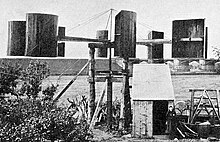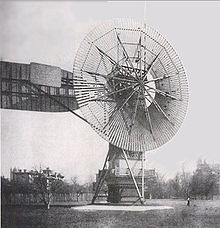Wind Energy
Scientists and engineers are using energy from the wind to generate electricity. Wind energy, or wind power, is created using a wind turbine.
As renewable energy technology continues to advance and grow in popularity, wind farms like this one have become an increasingly common sight along hills, fields, or even offshore in the ocean.
https://education.nationalgeographic.org/resource/wind-energy/
A wind turbine is a device that converts the kinetic energy of wind into electrical energy. As of 2020, hundreds of thousands of large turbines, in installations known as wind farms, were generating over 650 gigawatts of power, with 60 GW added each year.[1] Wind turbines are an increasingly important source of intermittent renewable energy, and are used in many countries to lower energy costs and reduce reliance on fossil fuels. One study claimed that, as of 2009, wind had the "lowest relative greenhouse gas emissions, the least water consumption demands and the most favorable social impacts" compared to photovoltaic, hydro, geothermal, coal and gas energy sources.[2]
Smaller wind turbines are used for applications such as battery charging for auxiliary power for boats or caravans, and to power traffic warning signs. Larger turbines can contribute to a domestic power supply while selling unused power back to the utility supplier via the electrical grid.
Wind turbines are manufactured in a wide range of sizes, with either horizontal or vertical axes.
History
The windwheel of Hero of Alexandria (10 AD – 70 CE) marks one of the first recorded instances of wind powering a machine.[3][4] However, the first known practical wind power plants were built in Sistan, an Eastern province of Persia (now Iran), from the 7th century. These "Panemone" were vertical axle windmills, which had long vertical drive shafts with rectangular blades.[5] Made of six to twelve sails covered in reed matting or cloth material, these windmills were used to grind grain or draw up water, and were used in the gristmilling and sugarcane industries.[6]
Wind power first appeared in Europe during the Middle Ages. The first historical records of their use in England date to the 11th and 12th centuries; there are reports of German crusaders taking their windmill-making skills to Syria around 1190.[7] By the 14th century, Dutch windmills were in use to drain areas of the Rhine delta. Advanced wind turbines were described by Croatian inventor Fausto Veranzio in his book "Machinae Novae" (1595), he described vertical axis wind turbines with curved or V-shaped blades.

The first electricity-generating wind turbine was a battery-charging machine installed in July 1887 by Scottish academic James Blyth to light his holiday home in Marykirk, Scotland.[8] Some months later, American inventor Charles F. Brush was able to build the first automatically operated wind turbine after consulting local University professors and his colleagues Jacob S. Gibbs and Brinsley Coleberd and successfully getting the blueprints peer-reviewed for electricity production.[8] Although Blyth's turbine was considered uneconomical in the United Kingdom,[8] electricity generation by wind turbines was more cost effective in countries with widely scattered populations.[7]
In Denmark by 1900, there were about 2500 windmills for mechanical loads such as pumps and mills, producing an estimated combined peak power of about 30 megawatts (MW). The largest machines were on 24-meter (79 ft) towers with four-bladed 23-meter (75 ft) diameter rotors. By 1908, there were 72 wind-driven electric generators operating in the United States from 5 kilowatts (kW) to 25 kW. Around the time of World War I, American windmill makers were producing 100,000 farm windmills each year, mostly for water-pumping.[10]
By the 1930s, wind generators for electricity were common on farms, mostly in the United States where distribution systems had not yet been installed.
A forerunner of modern horizontal-axis wind generators was in service at Yalta, USSR in 1931. This was a 100 kW generator on a 30-meter (98 ft) tower, connected to the local 6.3 kV distribution system. It was reported to have an annual capacity factor of 32 percent, not much different from current wind machines.[11][12]
In the autumn of 1941, the first megawatt-class wind turbine was synchronized to a utility grid in Vermont. The Smith–Putnam wind turbine only ran for 1,100 hours before suffering a critical failure. The unit was not repaired, because of a shortage of materials during the war.
The first utility grid-connected wind turbine to operate in the UK was built by John Brown & Company in 1951 in the Orkney Islands.[8][13]
Despite these diverse developments, developments in fossil fuel systems almost eliminated any wind turbine systems larger than supermicro size. In the early 1970s, however, anti-nuclear protests in Denmark spurred artisan mechanics to develop microturbines of 22 kW. Organizing owners into associations and co-operatives led to the lobbying of the government and utilities and provided incentives for larger turbines throughout the 1980s and later. Local activists in Germany, nascent turbine manufacturers in Spain, and large investors in the United States in the early 1990s then lobbied for policies that stimulated the industry in those countries.
It has been argued that expanding the use of wind power will lead to increasing geopolitical competition over critical materials for wind turbines, such as rare earth elements neodymium, praseodymium, and dysprosium. However, this perspective has been critically dismissed for failing to relay how most wind turbines do not use permanent magnets and for underestimating the power of economic incentives for the expanded production of these minerals.[14]
https://en.wikipedia.org/wiki/Wind_turbine



